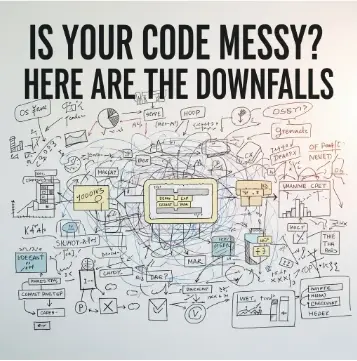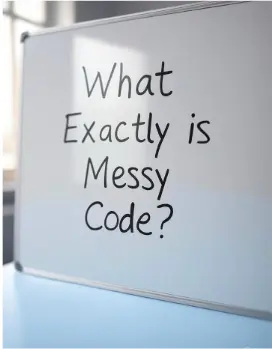Is Your Code Messy? Here Are the Downfalls

Introduction
Let's be honest, we've all been there. Staring at a screen full of code that looks like a digital spaghetti monster. Maybe it's code you wrote yourself months ago, or perhaps it's something you inherited from a previous developer. Either way, dealing with messy code is a common, and often frustrating, part of being a programmer. But what exactly are the downfalls of letting your codebase become a tangled mess? This article dives deep into the problems caused by messy code and, more importantly, provides practical solutions to keep your projects clean and maintainable. Think of this as your guide to transforming from a code hoarder to a codingMarie Kondo!
What Exactly is Messy Code?

Messy code isn't just about aesthetics (though that's part of it!). It's about code that's difficult to understand, modify, and debug. It lacks clarity and structure, making it a nightmare to work with. Here are some common characteristics:
- Lack of Comments: Code that's not properly commented is like a map without labels.
- Inconsistent Formatting: Indentation errors, mixed casing, and inconsistent spacing make code visually unappealing and harder to read.
- Long Functions/Methods: Functions that do too much are hard to understand and test.
- Duplicated Code: Copying and pasting code leads to redundancy and increases the risk of errors.
- Poor Naming Conventions: Variables and functions with unclear or misleading names.
- Complex Logic: Deeply nested loops and conditional statements that are hard to follow.
Think of it this way: if another developer (or even your future self) can't easily understand what your code does, it's probably messy.
The Real Costs of Messy Code
Messy code isn't just an annoyance; it has real, tangible costs that can impact your projects and your team's productivity. Let's break down some of the key downfalls:
- Increased Development Time: Debugging and modifying messy code takes significantly longer.
- Higher Maintenance Costs: Maintaining a messy codebase is expensive and time-consuming.
- Increased Risk of Bugs: Messy code is more prone to errors and bugs.
- Reduced Team Morale: Working with messy code is frustrating and can lead to decreased job satisfaction.
- Difficulty Onboarding New Developers: New team members will struggle to understand and contribute to a messy codebase.
- Technical Debt: Messy code contributes to technical debt, which can accumulate over time and cripple a project.
A Table of Pain: Comparing Clean vs. Messy Code
| Feature | Clean Code | Messy Code |
|---|---|---|
| Readability | Easy to understand | Difficult to understand |
| Maintainability | Easy to maintain and modify | Difficult and costly to maintain |
| Debugging | Easy to debug | Prone to errors, hard to debug |
| Development Time | Faster development cycles | Slower development cycles |
| Team Morale | High | Low |
Recognizing Messy Code: Spotting the Red Flags
Knowing what messy code looks like is the first step to addressing the problem. Here are some red flags to watch out for:
- Code Smells: These are indicators that something might be wrong with your code. Common examples include long methods, large classes, and duplicated code.
- High Cyclomatic Complexity: This measures the number of linearly independent paths through your code. High complexity indicates that your code is difficult to test and understand.
- Low Code Coverage: If your code has low test coverage, it's more likely to contain bugs and be difficult to refactor.
- The "WTF/minute" Metric: A highly unscientific, yet often accurate, measure of how confusing your code is. If you find yourself uttering "WTF" frequently while reading your code, that's a bad sign!
Common Code Smells
- Long Method: A method that is too long and does too many things.
- Large Class: A class that has too many responsibilities.
- Duplicated Code: Identical or very similar code in multiple places.
- God Class: A class that knows too much or does too much.
- Feature Envy: A method that seems more interested in a class other than the one it actually belongs to.
Practical Solutions: Cleaning Up Your Act
Okay, so you've identified that your code is a bit of a mess. Don't panic! Here are some practical solutions you can implement to clean things up:
- Refactoring: This involves restructuring existing code without changing its external behavior. It's like renovating your house without changing its foundation.
- Writing Unit Tests: Unit tests help you identify and fix bugs early on. They also make it easier to refactor your code with confidence.
- Code Reviews: Have other developers review your code. They can provide valuable feedback and catch errors you might have missed.
- Using a Linter: Linters are tools that automatically check your code for style errors and potential problems.
- Breaking Down Complex Functions: Divide long, complex functions into smaller, more manageable units.
- Removing Duplicated Code: Identify and eliminate duplicated code by creating reusable functions or classes.
Example: Refactoring a Long Method
Let's say you have a long method that calculates the price of an order with various discounts and taxes. You can refactor it into smaller, more focused methods:
// Before
function calculateOrderTotal(order) {
let subtotal = 0;
for (let item of order.items) {
subtotal += item.price * item.quantity;
}
let discount = 0;
if (order.coupon) {
discount = calculateDiscount(subtotal, order.coupon);
}
let tax = calculateTax(subtotal - discount, order.state);
return subtotal - discount + tax;
}
// After
function calculateSubtotal(order) {
let subtotal = 0;
for (let item of order.items) {
subtotal += item.price * item.quantity;
}
return subtotal;
}
function calculateDiscount(subtotal, coupon) {
// ... discount logic ...
}
function calculateTax(amount, state) {
// ... tax logic ...
}
function calculateOrderTotal(order) {
let subtotal = calculateSubtotal(order);
let discount = calculateDiscount(subtotal, order.coupon);
let tax = calculateTax(subtotal - discount, order.state);
return subtotal - discount + tax;
}
Prevention is Better Than Cure: Writing Clean Code From the Start
The best way to deal with messy code is to prevent it from happening in the first place. Here are some tips for writing clean code from the start:
- Follow Coding Standards: Adhere to established coding standards for your language or framework.
- Write Clear and Concise Code: Keep your code simple and easy to understand.
- Use Meaningful Names: Choose descriptive names for variables, functions, and classes.
- Write Unit Tests: Writing tests as you go helps you catch bugs early and ensures that your code is testable.
- Practice Code Reviews: Regularly review each other's code to catch potential problems.
- The Boy Scout Rule: Always leave the campground cleaner than you found it. If you see something that can be improved, fix it, even if it's not directly related to the task you're working on.
Key Principles of Clean Code
- KISS (Keep It Simple, Stupid): Avoid over-engineering and keep your code as simple as possible.
- DRY (Don't Repeat Yourself): Eliminate duplicated code by creating reusable functions or classes.
- YAGNI (You Ain't Gonna Need It): Don't add features or functionality until you actually need them.
Conclusion
Messy code is a common problem, but it's one that can be addressed with the right knowledge and practices. By understanding the downfalls of messy code, recognizing the red flags, and implementing practical solutions, you can create a cleaner, more maintainable codebase. Remember, writing clean code is not just about making your code look pretty; it's about improving your productivity, reducing the risk of bugs, and making your life as a developer much easier. So, take the time to clean up your act, and you'll reap the rewards in the long run. Happy coding!